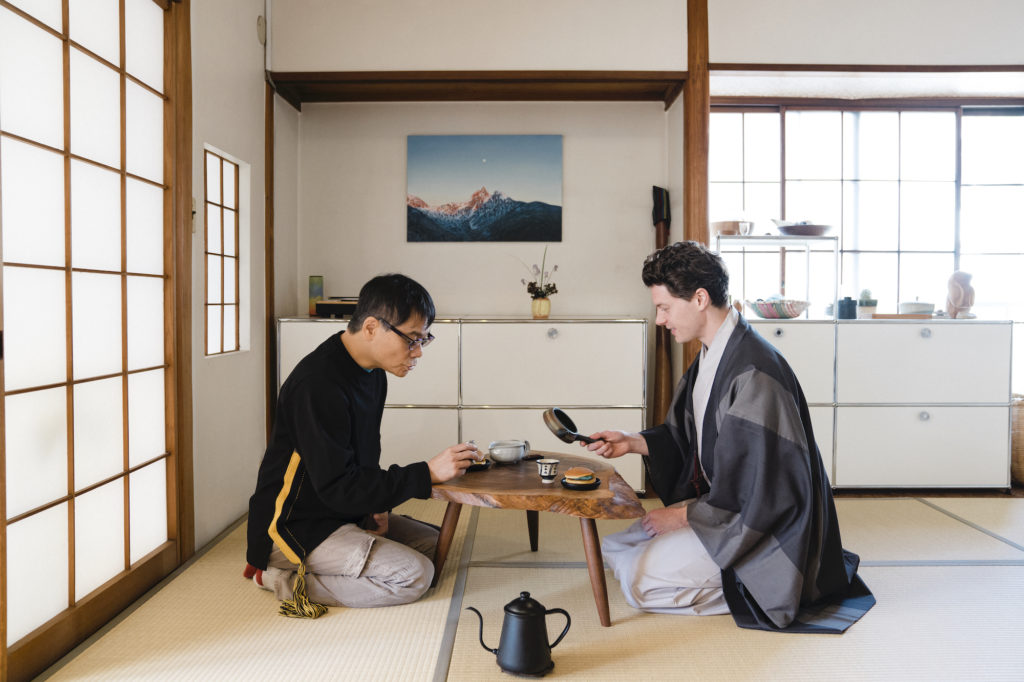Tea is a living, constantly evolving culture
Oscar: Today’s tea is Kondowase, an extremely rare cultivar grown in the Mariko community of Shizuoka City. It’s an orthodox Sencha tea leaf, but the partly Indian genome of the tea plant gives rise to a unique floral aroma reminiscent of black tea.
Seiko: Is it an old cultivar?
Oscar: The cultivar was produced some 30 years ago. But it became available as a single estate tea only 20 years ago. Although a broad variety of cultivars had existed until then, the tea sold on the market were blends of multiple leaves from different producers. Only recently can single estate tea be enjoyed like single vineyard wine.
Seiko: Who knew there were such fresh developments in the world of tea?
Oscar: For many people, tea brings to mind the classical tea ceremony and the ancient culture in the Sengoku period of civil wars when tea wares were awarded for victory in battle and the tea room became a ritual place to connect and negotiate. But tea is a living, constantly evolving culture. Cultivars that didn’t exist a couple of years ago are emerging today, and new cultivars will continue to emerge in the future.
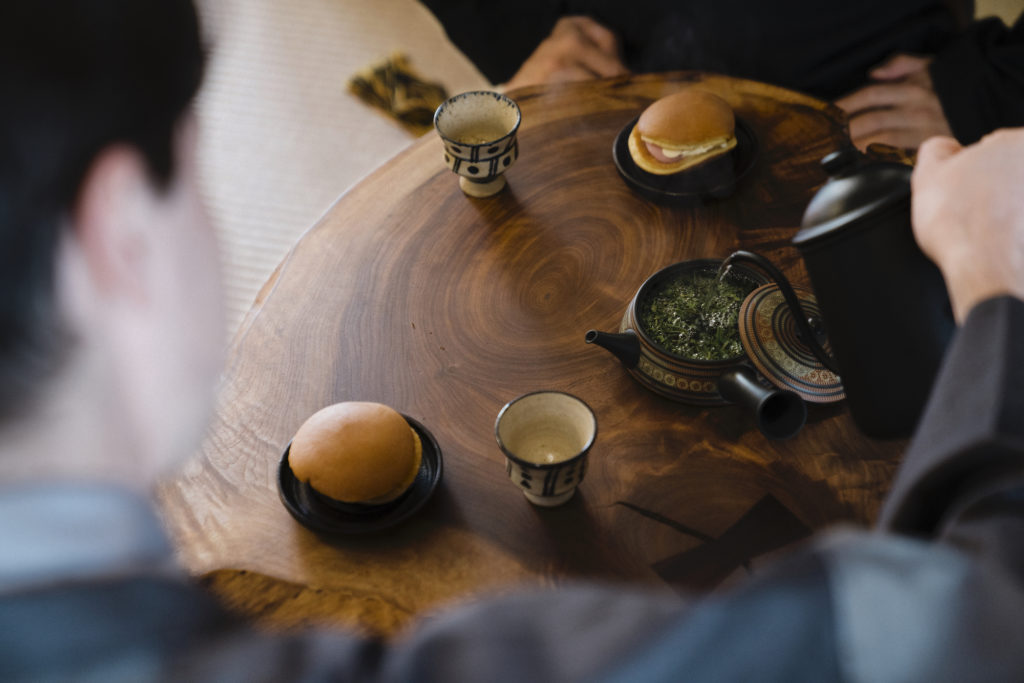
Beyond bitterness and astringency, a fresh forest-like fragrance
——The first brew. To soften the astringency and bitterness, and accentuate the umami and sweetness of Sencha, normally the water is brought to a boil and then left to cool. Oscar, however, pours boiling water into the teapot. This comes as a surprise even to Seiko. Won’t the tea turn bitter?
Oscar: For hot water, we reduce the amount of tea leaves to a bare minimum. Today, we are using about 2 grams. While this smaller number of leaves reduces everything — bitterness, astringency, and umami — it also produces a mild flavor, and, borrowing a wine term, a light body. The strong floral aroma of the tea leaves is sometimes mistaken for flavored tea. What do you think?
Seiko: You’re right, this doesn’t taste like ordinary Japanese tea. It has a nice mix of flavors. Wait, here comes the bitterness!
Oscar: Yes, but the bitterness is gentle and not too strong. This piping hot tea is perfect for cold winter mornings and over air-conditioned rooms in the summer. And this brewing method pairs well with Western confectionery like chocolate. With fewer tea leaves, we can go ahead and use boiling water as we would with black tea. This makes it easy for foreigners to prepare Japanese tea.
Seiko: Speaking of foreigners, were you very young when you discovered Japanese tea?
Oscar: I learned about the Meiji era of modernization in my high school world history course. That sparked my interest in Japanese culture and the Japanese tea ceremony. Convinced that the green leaves held some special secret, I went to a tea shop nearby and bought a package of Sencha. When I prepared my first brew as I would black tea, it turned out very bitter and astringent. I couldn’t bring myself to throw out the rest of the 100-gram package, though, and kept trying. In time, on the third or fourth try, I recognized that beyond the bitterness and astringency was a fresh, forest-like fragrance.
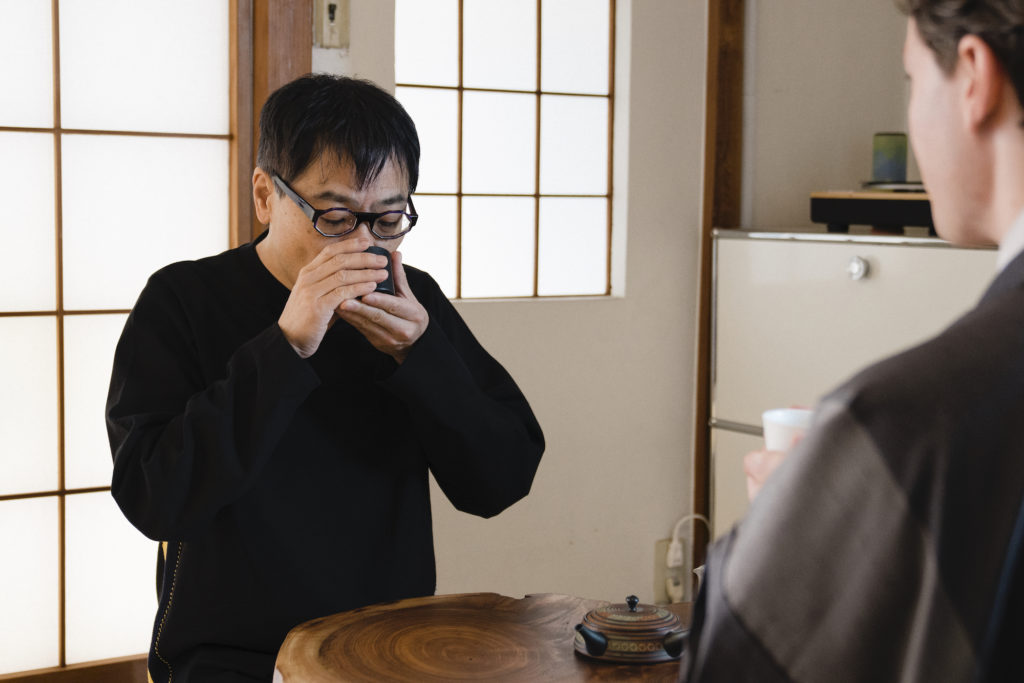
Dashi made from the forest
——This fueled Oscar’s passion for Japanese tea. He joined a study-abroad program at Japanese University and went on to work in Japan while studying to become a certified Japanese tea instructor. Of the countless joys of Japanese tea, Oscar most enjoys experimenting with different brewing techniques. He shows us an example by using ice water to brew a teapot full of tea leaves.
Seiko: Wow, that is a lot of tea leaves. What a luxury. But the water barely covers the heap. Are you sure that’s enough?
Oscar: People who see this for the first time may think I’m stingy. Actually, this is one of the most generous ways to enjoy Japanese tea. While this concentrated pour yields only a few drops, the intense umami and sweetness that results will explode in the mouth. We pour the ice water and let it sit for three minutes or so.
Seiko: I see. Because there’s no steam, there’s no need to place the lid on the teapot.
Oscar: They say tea is a feast for the palate and not the eyes. But this method allows you to see the beauty of the tea leaves unraveling, blossoming into a vibrant flower. It works only with Japanese tea.
Seiko: Can’t you make black tea with cold water?
Oscar: The tea would just come out weak. With black tea, you need boiling water to draw out the fragrance and astringency. With Japanese tea, cold water accentuates the umami and produces a taste like dashi stock. This is a very strong cup of tea. Take your time and enjoy it slowly.
Seiko: The umami taste is very strong. Yes, this is like dashi. It’s dashi made from the forest.
Oscar: Let’s add some ice water. Here you go. Enjoy the second brew.
Seiko: The taste has changed. This is a meadow. It reminds me of a tall sheaf of straw.
Oscar: These are the same tea leaves as the first cup. You can see how the change in preparation technique and number of brews makes a big difference in flavor.

The tea leaf represents a lifetime
Seiko: This tea leaf is like a person progressing through life, from childhood to youth to manhood to old age. It represents a lifetime.
Oscar: Japanese tea adds a sensual, aesthetic dimension to a practice in my home country called fika. The taste changing from the first to second to third brew means we can take our time and enjoy it. The process of preparation is naturally ideal for fika.
Seiko: What are the benefits of fika?
Oscar: The informal gathering relaxes us and encourages us to open up. Fika at the workplace, for example, lets you discuss things more casually than in meetings. The process of preparing and sharing the tea invites participants to explore their own creativity – “Might we try this?” – while being receptive to the ideas of others – “Your suggestion is intriguing. Might it work?” But Fika with friends is not all work. It might involve a little gossip. Perhaps someone needs romantic advice. When we relax together and connect, we begin to understand one another better. And sometimes, wonderful things happen.
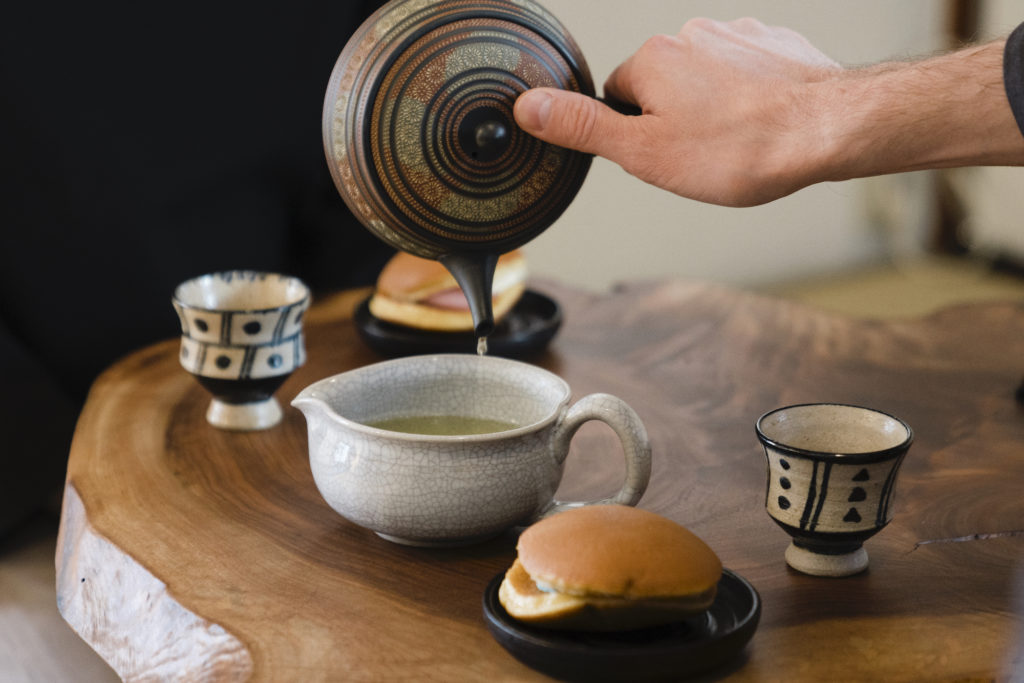
A flat and democratic platform
Seiko: So fika is a way to step outside your own world. It’s a flat and democratic platform for communication. For me, taking a break is a way to get my energy going, like before I start writing a manuscript. I have a feeling that learning to use your break time well can change your awareness, maybe even change you as a person.
Oscar: It certainly makes a change of pace. With Japanese tea, you can even enjoy the process of preparation.
Seiko: Speaking of Japanese tea, this is still good in the third and fourth brews.
Oscar: The tea first releases umami and sweetness. And when that fades, it’s replaced by a fresh astringency, refined bitterness, and stronger aroma.
Seiko: You mean the aroma gains definition as it ages? That’s wonderful. Talk about aging gracefully!
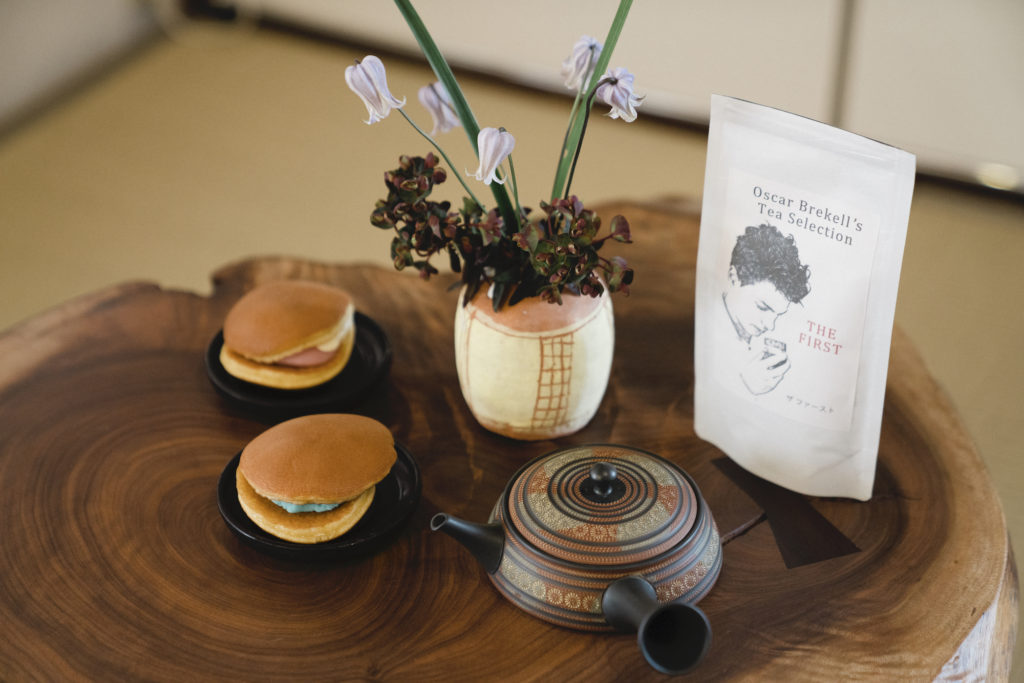
Japanese Fika Table
Tea | 「THE FIRST Kondowase」(Oscar Brekell’s Tea Selection)
This rare cultivar is grown in the Mariko community of Shizuoka City. Only 40 kilograms are harvested each season. The kyusu teapot is Oscar’s favorite work of Tokoname ware, from Aichi Prefecture, by master artisan Teruyuki Isobe.
Sweets | Specialty pancakes from Dorayaki Wadaya
“Tochiotome Strawberry Short Cake” and “The Chocolate Mint” by the dorayaki confectioner in Oyama City, Tochigi, blends white bean paste with mint and strawberry paste for eye-popping colors.
Flower | Foliage filtering the sun to the shade
Early summer blooming clematis is arranged with euphorbia and evergold by Chieko Ueno from Forager. The vase is by New York-based ceramic artist Shino Takeda.
